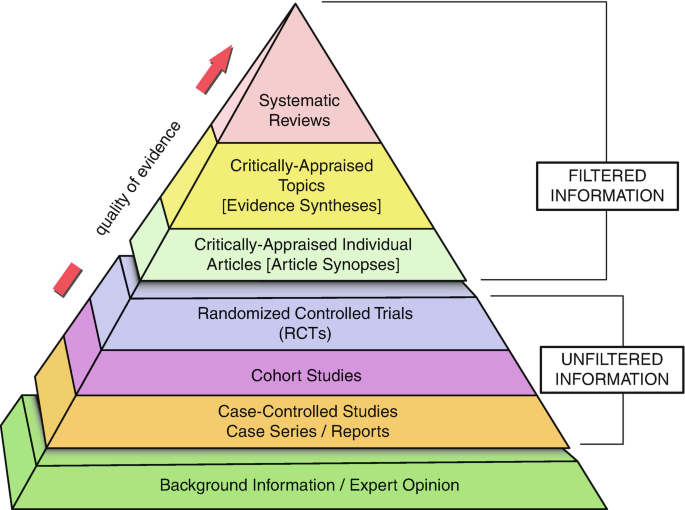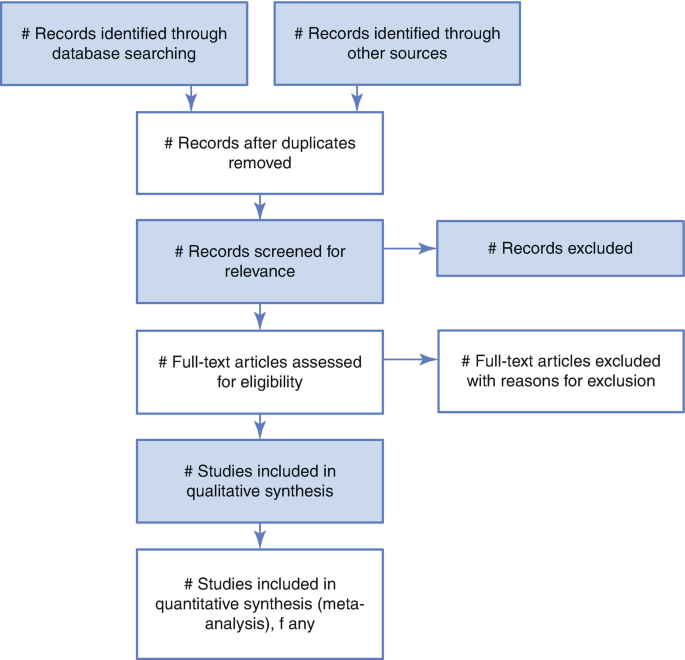Abstract
A Systematic Review is an attempt to distill the essence of a large number of studies in medicine by first asking a research question and then first identifying and later synthesizing carefully chosen studies of a high quality which might provide the answers. A more precise definition is ‘a summary of the medical literature that uses explicit and reproducible methods to systematically search, critically appraise and synthesise the results of multiple primary studies related to each other by using strategies to reduce bias and random errors’ [1].
You have full access to this open access chapter, Download chapter PDF
Similar content being viewed by others
1 What Is a Systematic Review?
A Systematic Review is an attempt to distill the essence of a large number of studies in medicine by first asking a research question and then first identifying and later synthesizing carefully chosen studies of a high quality which might provide the answers. A more precise definition is ‘a summary of the medical literature that uses explicit and reproducible methods to systematically search, critically appraise and synthesise the results of multiple primary studies related to each other by using strategies to reduce bias and random errors’ [1].
In 1979, Archibald Cochrane, a Scottish doctor, proposed: ‘It is surely a great criticism of our profession that we have not organised a critical summary, by specialty or subspecialty, adapted periodically, of all relevant randomised controlled trials’. Cochrane was one of the founding fathers of evidence-based medicine (Fig. 29.1). He highlighted and advocated the importance of critically summarizing the findings of research studies and designated the systematic review as a method of providing such a summary. This ultimately led to the development of the Cochrane Collaboration in 1993 [2]. The findings of systematic reviews are now widely used for clinical decision-making and have become integral towards the development of sound clinical practice guidelines and recommendations. In fact, they now occupy the summit of the pyramid for the quality of evidence.
2 How Is a Systematic Review Done?
It is done using the following steps:
Step 1—Defining the research question clearly and formulating criteria for which reports to include.
Searching for and selecting these studies and collecting their data. This will involve a review of all the available databases and citation indexes like the Web of Science, Embase, PubMed and others using different search technologies or even artificial intelligence-based tools. Each study should conform to the PRISMA (Preferred Reporting Items for Systemic Reviews and Meta-Analyses) guidelines or the standards of the Cochrane Collaboration [3].
The PRISMA guidelines (Fig. 29.2) are steps that depict the flow of information through the different phases of a systematic review. It maps out the number of records identified, included and excluded, and the reasons for exclusions.
Step 2—Assess their risk of bias. The review should use an objective and transparent approach for collection and synthesizing the data to minimize bias.
Step 3—Analyse the data and undertake a meta-analysis. This may involve using complex statistical methods and the more data that is analyzed the more confident we can be of the result.
Step 4—Write conclusions. Present the results and summarize the findings. Interpret the results, draw conclusions and suggest a message.
3 Why Is a Systematic Review Useful?
Many clinical decisions are guided by published studies but, unfortunately, there are now too many to choose from for a busy clinician. These studies often vary in their design, methodological quality, population involved and the intervention or condition considered. To take a rational clinical decision involves trying to reconcile the results of studies that provide different answers to the same question. Because it is often impractical for readers to track down and read all of the primary studies, systematic review articles are an important source of summarized evidence on a particular topic [4, 5].
4 What Are Its Weaknesses?
Most systematic reviews focus on a single question when more than one may be relevant in a particular situation, e.g., the best treatment for variceal bleeding in a developed country may be endoscopic sclerotherapy but not in a person in a developing country who is poor, has good liver function and does not have access to sophisticated medical facilities. In him or her a portosystemic shunt operation and a one-time procedure may be the more appropriate.
Then search strategies are often not provided in detail, the selection of studies may be biased, and only the positive results may reach publication. It also takes about 6 months to complete a single systematic review [6, 7].
5 What Is a Meta-Analysis? How Does It Differ from a Systematic Review?
A meta-analysis is a summary of data collected from multiple sources by collating it and helping to frame guidelines. While a systematic review includes the entire process of collecting, reviewing and presenting all available evidence, a meta-analysis only refers to the statistical technique of extracting and combining the data to produce a summary [7, 8].
6 What Are Scoping and Narrative Reviews? How Do They Differ from a Systematic Review?
A Scoping review is a preliminary assessment of the potential size and scope of the available research literature. It aims to identify the nature and extent of research evidence (usually including ongoing research) and present an overview of a potentially large and diverse body of literature pertaining to a broad topic. In contrast, a systematic review attempts to collate empirical evidence from a relatively smaller number of studies pertaining to a focused research question.
A Narrative review is the type first-year college students often learn as a general approach. Its purpose is to identify a few studies that describe a problem of interest. Narrative reviews have no predetermined research question or specified search strategy, only a topic of interest. They are not systematic and follow no specified protocol. No standards or protocols guide the review. Although the reviewers will learn about the problem, they will not arrive at a comprehensive understanding of the state of the science related to the problem [9, 10]. No strict rules are there for narrative review and can be done using the keywords.
7 Conclusions
-
A Systemic review gives a comprehensive and complete plan and search approach to study a topic of interest. This reduces the bias by recognizing, assessing and creating all relevant studies on a particular topic.
-
Systematic reviews can be ambiguous, not helpful, or even harmful when data are incorrectly handled.
-
A Meta-analysis involves using statistical methods to create the data from several studies into a single quantitative study.
-
Outcomes from a meta-analysis may help to estimate the effect of treatment or risk factors for disease, or other outcomes.
References
Uman LS. Systematic reviews and meta-analyses. J Can Acad Child Adolesc Psychiatry. 2011;20:57–9.
Stavrou A, Challoumas D, Dimitrakakis G. Archibald Cochrane (1909–1988): the father of evidence-based medicine. Interact Cardiovasc Thorac Surg. 2014;18:121–4.
Preferred Reporting Items for Systematic Reviews and Meta-Analyses (PRISMA). Last accessed on 3rd August 2020. Available on http://www.prisma-statement.org/.
Gopalakrishnan S, Ganeshkumar P. Systematic reviews and meta-analysis: understanding the best evidence in primary healthcare. J Family Med Prim Care. 2013;2:9–14.
Why systematic reviews matter. A brief history, overview and practical guide for authors. Last accessed on 3rd August 2020. Available on https://www.elsevier.com/connect/authors-update/why-systematic-reviews-matter.
Yuan Y, Hunt RH. Systematic reviews: the good, the bad, and the ugly. Am J Gastroenterol. 2009;104:1086–92.
Ahn E, Kang H. Introduction to systematic review and meta-analysis. Korean J Anesthesiol. 2018;71(2):103–12.
Haidich AB. Meta-analysis in medical research. Hippokratia. 2010;14(Suppl 1):29–37.
Munn Z, Peters MDJ, Stern C, et al. Systematic review or scoping review? Guidance for authors when choosing between a systematic or scoping review approach. BMC Med Res Methodol. 2018;18:143.
Pham MT, Rajić A, Greig JD, Sargeant JM, Papadopoulos A, McEwen SA. A scoping review of scoping reviews: advancing the approach and enhancing the consistency. Res Synth Methods. 2014;5(4):371–85.
Author information
Authors and Affiliations
Rights and permissions
Open Access This chapter is licensed under the terms of the Creative Commons Attribution 4.0 International License (http://creativecommons.org/licenses/by/4.0/), which permits use, sharing, adaptation, distribution and reproduction in any medium or format, as long as you give appropriate credit to the original author(s) and the source, provide a link to the Creative Commons license and indicate if changes were made.
The images or other third party material in this chapter are included in the chapter's Creative Commons license, unless indicated otherwise in a credit line to the material. If material is not included in the chapter's Creative Commons license and your intended use is not permitted by statutory regulation or exceeds the permitted use, you will need to obtain permission directly from the copyright holder.
Copyright information
© 2022 The Author(s)
About this chapter
Cite this chapter
Nundy, S., Kakar, A., Bhutta, Z.A. (2022). Systematic, Scoping and Narrative Reviews. In: How to Practice Academic Medicine and Publish from Developing Countries?. Springer, Singapore. https://doi.org/10.1007/978-981-16-5248-6_29
Download citation
DOI: https://doi.org/10.1007/978-981-16-5248-6_29
Published:
Publisher Name: Springer, Singapore
Print ISBN: 978-981-16-5247-9
Online ISBN: 978-981-16-5248-6
eBook Packages: MedicineMedicine (R0)






